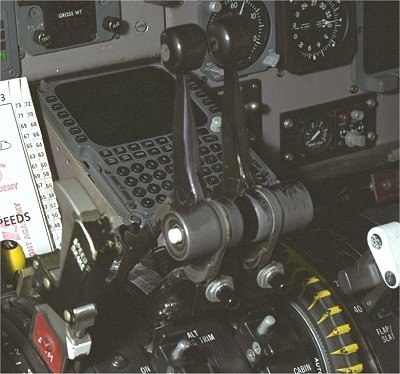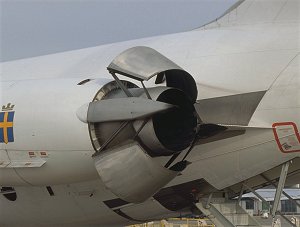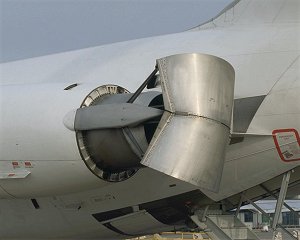ENGINE THRUST REVERSERS. Each thrust reverser has two, hydraulically operated, doors.
Each thrust reverser has two, hydraulically operated, doors.
The reverser lever on the throttle controls the position of the doors as well as the reverse power setting. The lever can only be moved into reverse range when the throttle is in idle position. Initial aft movement of the lever to its interlock stop releases the door safety latch, deenegizes the shutoff valve solenoid and moves the reverser control valve into reverse position. When the doors are extended to reverse position, the interlock stop will be released, allowing maximum reverse thrust operation. Observe - there is no technical device that will prevent the pilot from applying reverse thrust at FL 310. The system is "failsafe" but not "fool proof".Each thrust reverser is powered by its respective hydraulic system. In case of system failure, accumulators are capable of operating the reverser doors for one extension and a partial retraction cycle. The doors are canted approximately 17 degrees from the vertical to deflect the reversed exhaust away from the air intake. The time interval between reverser initial actuation and full deployment is approximately two seconds.

Reverse thrust operation
Tailblanking. When using reverse thrust, the forward deflected engine thrust may reduce, change direction or even block the flow of air passing the fin. On the MD80 this problem may be considerable.On slippery runways where stopping capability and directional control on the runway are in highest demand, this problem is maximized. The airflow past the vertical stabilizer and rudder is less disturbed in forward or idle thrust. When landing in strong crosswind, idle or low reverse thrust will give optimum directional stability on slippery runways as the vertical stabilizer and rudder efficiency is maximized, max EPR of 1.30 is used. The difference in landing distance is not significant unless the runway is very slippery (braking action < 0.2). The need for unreverse and canceling of brakes to regain directional control is eliminated. |